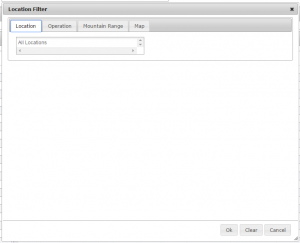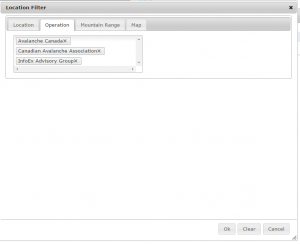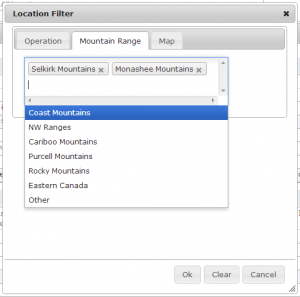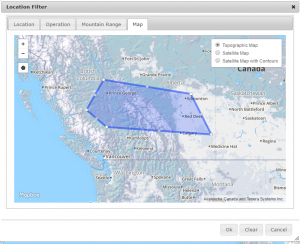Difference between revisions of "Restricting the locations included in an InfoEx report"
Jump to navigation
Jump to search
(→Background) |
(→Clearing a location filter) |
||
| (16 intermediate revisions by 2 users not shown) | |||
| Line 2: | Line 2: | ||
{{Requirements|UserLevel=All user levels|Connectivity=Online only}} | {{Requirements|UserLevel=All user levels|Connectivity=Online only}} | ||
| − | This document | + | This document describes how you can restrict the spatial extent of your InfoEx report by specifying what locations to include and how to clear the selection again. |
==Background== | ==Background== | ||
The application offers four possibilities for restricting the locations included in an InfoEx report: | The application offers four possibilities for restricting the locations included in an InfoEx report: | ||
| + | # [[#Location|Selecting the individual locations of your operation to be included]] | ||
# [[#Operation|Selecting the operations to be included]] | # [[#Operation|Selecting the operations to be included]] | ||
| − | # [[#MtnRange|Specifying the mountain ranges to be included | + | # [[#MtnRange|Specifying the mountain ranges to be included]] |
| − | |||
# [[#Polygon|Drawing a custom polygon]] | # [[#Polygon|Drawing a custom polygon]] | ||
| − | {{Note|Please note that the | + | {{Note|Please note that the five ways of specifying the locations are mutually exclusive and cannot be combined. In other words you cannot create a report that includes a number of operations <u>and</u> a mountain range. You can only create reports that either contain the observations of a number of operations or within an mountain range.}} |
| − | |||
| − | |||
==Step-by-step description== | ==Step-by-step description== | ||
| Line 31: | Line 29: | ||
|- | |- | ||
|class="StepNum" | | |class="StepNum" | | ||
| − | |[[File:ReportTabularViewLocationFilterOperationFilled.png|300px|thumb|right|Fig. | + | |[[File:ReportTabularViewLocationFilterLocationFilled.png|300px|thumb|right|Fig. 3: Location filter popup window with location selection]] '''<div id="Location">By locations:</div>''' |
| + | * Click on the {{ButtonGrey|Location}} tab at the top of the popup window. | ||
| + | * Click into the empty text box and start typing the name of the locations of your operation that you would like to be included in your report. The dropdown list will automatically list the locations what match with what you type. | ||
| + | * Include as many locations in your report as you like (Fig. 3). | ||
| + | * Click on {{ButtonGrey|Ok}} to submit your selection. | ||
| + | |- | ||
| + | |class="StepNum" | | ||
| + | |[[File:ReportTabularViewLocationFilterOperationFilled.png|300px|thumb|right|Fig. 4: Location filter popup window with operation selection]] '''<div id="Operation">By operations:</div>''' | ||
* Click on the {{ButtonGrey|Operation}} tab at the top of the popup window. | * Click on the {{ButtonGrey|Operation}} tab at the top of the popup window. | ||
* Click into the empty text box and start typing the name of the operation you would like to be included in your report. The dropdown list will automatically list the operations what match with what you type. | * Click into the empty text box and start typing the name of the operation you would like to be included in your report. The dropdown list will automatically list the operations what match with what you type. | ||
| − | * Include as many operations in your report as you like (Fig. | + | * Include as many operations in your report as you like (Fig. 4). |
* Click on {{ButtonGrey|Ok}} to submit your selection. | * Click on {{ButtonGrey|Ok}} to submit your selection. | ||
|- | |- | ||
|class="StepNum" | | |class="StepNum" | | ||
| − | |[[File:ReportTabularViewLocationFilterMtnRangeFilled.png|300px|thumb|right|Fig. | + | |[[File:ReportTabularViewLocationFilterMtnRangeFilled.png|300px|thumb|right|Fig. 5: Location filter popup window with mountain range selection]] '''<div id="MtnRange">By mountain range:</div>''' |
* Click on the {{ButtonGrey|Mountain Range}} tab at the top of the popup window. | * Click on the {{ButtonGrey|Mountain Range}} tab at the top of the popup window. | ||
* Click into the empty text box and start typing the name of the mountain range you would like to be included in your report. The dropdown list will automatically list the mountain ranges what match with what you type. | * Click into the empty text box and start typing the name of the mountain range you would like to be included in your report. The dropdown list will automatically list the mountain ranges what match with what you type. | ||
| − | * Include as many mountain ranges in your report as you like (Fig. | + | * Include as many mountain ranges in your report as you like (Fig. 5). |
* Click on {{ButtonGrey|Ok}} to submit your selection. | * Click on {{ButtonGrey|Ok}} to submit your selection. | ||
|- | |- | ||
|class="StepNum" | | |class="StepNum" | | ||
| − | + | |[[File:ReportTabularViewLocationFilterMapFilled.png|300px|thumb|right|Fig. 6: Location filter popup window with map selection]] '''<div id="Polygon">By custom polygon:</div>''' | |
| − | |||
| − | |||
| − | |||
| − | |||
| − | |||
| − | |||
| − | |||
| − | |[[File:ReportTabularViewLocationFilterMapFilled.png|300px|thumb|right|Fig. 6: Location filter popup window with map selection]] '''<div id="Polygon">By custom polygon</div>''' | ||
* Click on the {{ButtonGrey|Map}} tab at the top of the popup window. | * Click on the {{ButtonGrey|Map}} tab at the top of the popup window. | ||
| − | + | * Navigate to the general location that you want to include in your report. | |
| − | * Navigate to the general location that want to include in your report. | + | * Click on [[File:ButtonDrawPolygon.png]] and draw your polygon. |
| − | * Click on | ||
| − | |||
| − | |||
* Modify the custom polygon until you have the shape you like (Fig. 6). | * Modify the custom polygon until you have the shape you like (Fig. 6). | ||
* Click on {{ButtonGrey|Ok}} to submit your selection. | * Click on {{ButtonGrey|Ok}} to submit your selection. | ||
|- | |- | ||
|class="StepNum" | 4. | |class="StepNum" | 4. | ||
| − | |[[File:ReportTabularViewLocationWithLocFilter.png|300px|thumb|right|Fig. 7: InfoEx report with location filter active.]] Wait until the application | + | |[[File:ReportTabularViewLocationWithLocFilter.png|300px|thumb|right|Fig. 7: InfoEx report with location filter active.]] Wait until the application has retrieved the data for the new location filter from the server and displays it in the current view. The locations included in your report are now listed in the location field at the top of the InfoEx report (Fig. 7). |
|} | |} | ||
| Line 82: | Line 76: | ||
|class="StepNum" | 4. | |class="StepNum" | 4. | ||
|[[File:ReportTabularView.png|300px|thumb|right|Fig. 10: Overview of tabular report view]] Wait until the application has retrieved the data from the server and displays it in the current view. The locations field at the top of the InfoEx report is now clear (Fig. 10). | |[[File:ReportTabularView.png|300px|thumb|right|Fig. 10: Overview of tabular report view]] Wait until the application has retrieved the data from the server and displays it in the current view. The locations field at the top of the InfoEx report is now clear (Fig. 10). | ||
| − | |||
|} | |} | ||
==Related documents== | ==Related documents== | ||
| − | + | {{PagesInfoExReport}} | |
| − | |||
| − | |||
| − | |||
| − | |||
| − | |||
| − | |||
| − | |||
| − | |||
| − | |||
| − | |||
| − | |||
| − | |||
| − | |||
| − | |||
| − | |||
| − | |||
| − | |||
| − | |||
==Functionality tested by== | ==Functionality tested by== | ||
Latest revision as of 13:37, 31 May 2017
| REQUIREMENTS | |
| Permission | All user levels |
| Connectivity | Online only |
This document describes how you can restrict the spatial extent of your InfoEx report by specifying what locations to include and how to clear the selection again.
Background
The application offers four possibilities for restricting the locations included in an InfoEx report:
- Selecting the individual locations of your operation to be included
- Selecting the operations to be included
- Specifying the mountain ranges to be included
- Drawing a custom polygon
| NOTE | Please note that the five ways of specifying the locations are mutually exclusive and cannot be combined. In other words you cannot create a report that includes a number of operations and a mountain range. You can only create reports that either contain the observations of a number of operations or within an mountain range. |
Step-by-step description
Creating a location filter
| 1. | Click into the empty text box under the 'Location' label of the report view (Fig. 1). |
| 2. | This will open a popup window called 'Location Filter' with four tabs across the top (Fig. 2). |
| 3. | Use one of the following methods for specifying the locations you would like to be included in your report. |
| By locations:
| |
| By operations:
| |
| By mountain range:
| |
| By custom polygon:
| |
| 4. | Wait until the application has retrieved the data for the new location filter from the server and displays it in the current view. The locations included in your report are now listed in the location field at the top of the InfoEx report (Fig. 7). |
Clearing a location filter
| 1. | Click into the filled text box under the 'Location' label of the report view (Fig. 8). |
| 2. | This will open a popup window called 'Location Filter' with four tabs across the top and the information of the current location filter (Fig. 9). |
| 3. | Click on Clear at the bottom of the popup window. This will erase the filter information and close the popup window. |
| 4. | Wait until the application has retrieved the data from the server and displays it in the current view. The locations field at the top of the InfoEx report is now clear (Fig. 10). |
Related documents
Customizing reports
[1] Click to watch a help video
[2] Click to watch a help video
- Content
- Specifying the date or date range of an InfoEx report
- Restricting the locations included in an InfoEx report
- Specifying the tables to be included in an InfoEx report
- Adding or removing columns of individual tables in an InfoEx report
- Applying filters to individual tables in an InfoEx report
- Including or excluding proprietary information in an InfoEx report
- Layout
Managing report templates
- Saving a report as an InfoEx report template
- Modifying an existing InfoEx report template
- Deleting an existing InfoEx report template
- Signing up for the daily InfoEx report emails
Viewing report templates
Map Layers
- Operation overview
- Avalanche observations
- Avalanche hazard
- Snow Profiles
- Field summary
- Weather observations
- Time slider (used for all map layers)
- Additional external information sources
Charts
Functionality tested by
- Dec. 31, 2013: Pascal Haegeli






